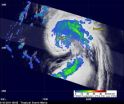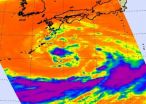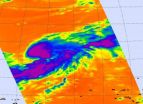(Press-News.org) Watching children on the playground, we see them run, climb, slide, get up, and do it all again. While their movements are continuous, we language-users can easily divide them up and name each one. But what about people—babies—who don't yet have words? How do they make sense of a world in motion?
An upcoming study in Psychological Science, a journal published by the Association for Psychological Science, finds that infants at seven to nine months are able to slice up the flow of events, even before they start to speak. And the researchers believe they've identified the way that babies accomplish this feat.
Infants use "statistical learning"— they compute the likelihood that one event follows another and use that information to predict future events, says Sarah Roseberry, a post-doctoral fellow at the Institute for Learning & Brain Sciences at the University of Washington. Based on these probabilities, infants find boundaries between events, a critical step for learning words. Roseberry collaborated in the study with Russell Richie, Kathy Hirsh-Pasek, and Thomas Shipley of Temple University and Roberta Golinkoff of the University of Delaware.
In the experiment, 20 babies, half girls and half boys, watched a 4-minute video of 12 hand motions—such as crossed arms, palms together, or arms parallel—performed by a man whose face was blurred to filter out his eyes and emotions. The motions were performed continuously, with units of three hand motions always appearing together (crossed, palms, parallel). After they watched the video of continuous motion, the infants were shown videos of the hand motion units exactly as they'd seen them before (crossed, palms, parallel) or with the transitions between motions re-spliced at different points (circle, crossed, palms).
The experiment used the well-known fact that babies' gaze can tell you a lot about how they perceive things. In this case, the researchers watched for distinctions between familiar and novel movements. As expected, the babies looked significantly longer at the familiar videos—that is, the events that followed the statistical probabilities they'd learned—than at the re-spliced sequences.
Other research has shown that babies use statistics to find the boundaries between syllables in the language they hear, and that they track probabilities in series of static pictures—say, a triangle, a diamond, and a square. But this study is the first to observe statistical learning with "continuous, dynamic events," say the authors.
Roseberry says the work adds to a growing understanding of the earliest building blocks of language. "Although these babies were between just 7 and 9 months of age, they were already dividing the world into events" using the "tool" of statistical learning. "It is these events that will be named with words," she continues. "A few months later, when they can hook up words to the events they see, they will begin to use language."
###
For more information about this study, please contact: Sarah Roseberry at sarahr28@uw.edu.
The APS journal Psychological Science is the highest ranked empirical journal in psychology. For a copy of the article "Babies catch a break: 7- to 9-month-olds track statistical probabilities in continuous dynamic events" and access to other Psychological Science research findings, please contact Lucy Hyde at 202-293-9300 or lhyde@psychologicalscience.org.
END
Researchers have identified promising new therapies for ependymoma, a rare tumor with few treatment options. St. Jude Children's Research Hospital investigators led the effort, which used a new, faster drug development system that combines the latest drug screening technology with the first accurate animal model of the tumor.
Investigators identified several dozen new and existing drugs as possible ependymoma treatment candidates. The drugs were found by screening 5,303 existing medicines, natural products and other compounds for activity against the tumor, which develops ...
To highlight Pain Awareness Month in September, The Gerontological Society of America (GSA) — the nation's largest interdisciplinary organization devoted to the field of aging — is announcing two forthcoming publications focused on pain relief and medication for seniors.
Paired with its other recent research findings, GSA aims to provide readers with information on how new advances in pain prevention, treatment, and management may improve care and quality of life for older adults.
Both new publications are part of GSA's From Publication to Practice series, which aims ...
PHILADELPHIA - The changing tide of Alzheimer's diagnosis presents new challenges to the public, physicians and lawmakers: if you could find out your Alzheimer's risk, would you want to know? How should doctors tell you your risk? And what does it mean for the many newly diagnosed Americans still in the workplace?
Despite the emergence of new tools that can diagnose Alzheimer's earlier, no effective interventions have been identified to stop the progression of the disease. A new report from the Perelman School of Medicine at the University of Pennsylvania tackles the ...
NASA's TRMM satellite peers through clouds and can decipher the rate rain is falling within a tropical cyclone, and data from the satellite shows that the heaviest rainfall is occurring in the northwestern quadrant of the storm, away from Bermuda.
The Tropical Rainfall Measuring Mission (TRMM) satellite traveled above tropical storm Maria on Thursday, September 15, 2011 at 1001 UTC ( 6:01 a.m. EDT). TRMM has the ability to measure rainfall rates and cloud heights, two factors that are important and helpful to the National Hurricane Center (NHC) meteorologists who are ...
A new model of obsessive-compulsive disorder (OCD) that mirrors both symptoms of the disease and the timing of its treatment in humans has been created by University of Chicago researchers, according to a new study.
Using the model, researchers isolated a single neurotransmitter receptor in a specific brain region responsible for their model's OCD-like symptoms, offering new insight into the cause of the disorder. Further research with the model may point the way to new treatments for both OCD and autism, said Nancy Shanahan, PhD, lead author of the paper in Biological ...
Tropical Storm Roke is showing some signs of intensification on NASA infrared satellite imagery, as areas of strong convection and very cold cloud tops were spotted. Kadena Air Base in Okinawa is now in Roke's sights and should be making preparations.
NASA's Aqua satellite flew over Roke yesterday and the Atmospheric Infrared Sounder (AIRS) instrument showed powerful convection building around the storm's center and over the northern edge. Meanwhile, dry air is wrapping into the low-level center from the southwest, and limiting cloud development.
Infrared imagery provides ...
Infrared satellite imagery from NASA's Aqua satellite yesterday showed powerful convection building in the low pressure area known as System 94W and provided forecasters with an inside look that the low was strengthening. System 94W did intensify and became Tropical Storm Sonca today.
Infrared imagery is gathered by the Atmospheric Infrared Sounder (AIRS) instrument that flies on NASA's Aqua satellite. It provides valuable information to forecast organizations such as the Joint Typhoon Warning Center and National Hurricane Center about cloud temperatures and heights and ...
Cake Decorating Teacher's blog is dedicated to serving online viewers with a listing of easy to make recipes. Weekly blog posts include delicious dessert recipes at www.cakedecoratingteacher.com along with how to instructions for their readers convenience.
Life has never been this easy when it comes to finding free access to great baking recipes since the Internet and its listing of blog sites such as Cake Decorating Teacher. Posts can easily be viewed under the posts section of their website. To stay updated on the latest posts readers can subscribe to the blog's RSS ...
AMES, Iowa – Even though a dwarf galaxy clear across the Milky Way looks to be a mouse, it may have once been a bear that slashed through the Milky Way and created the galaxy's spiral arms, writes an Iowa State University astronomer in the journal Nature.
Curtis Struck, an Iowa State professor of physics and astronomy, uses a News & Views commentary in the Sept. 15 issue of Nature to add context and color to a study published in the same issue by a research team led by Chris W. Purcell of the University of Pittsburgh.
The Purcell group reports that the Sagittarius Dwarf ...
After nearly two years of committed planning and design, the 2011 Solar Decathlon Team Massachusetts heads to Washington, D.C. where its completed "4D Home" will participate alongside 19 other collegiate entries in this year's competition. A unique dwelling that boasts both affordable and sustainable design elements, the "4D Home" is fully solar-powered, cost-effective and energy-efficient.
"Team Massachusetts showcases public higher education at its best. The creation of this self-sustaining home designed and developed by students at Massachusetts ...



